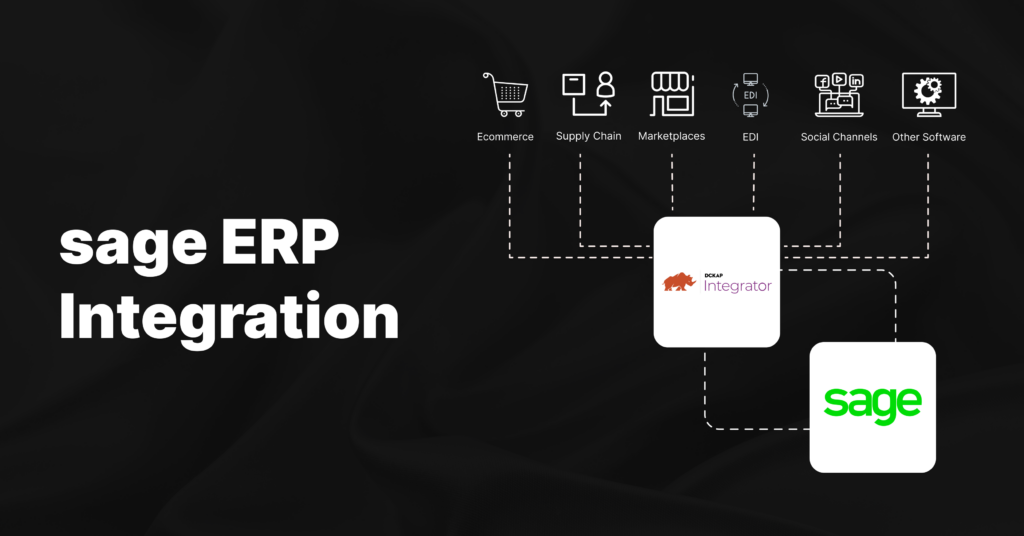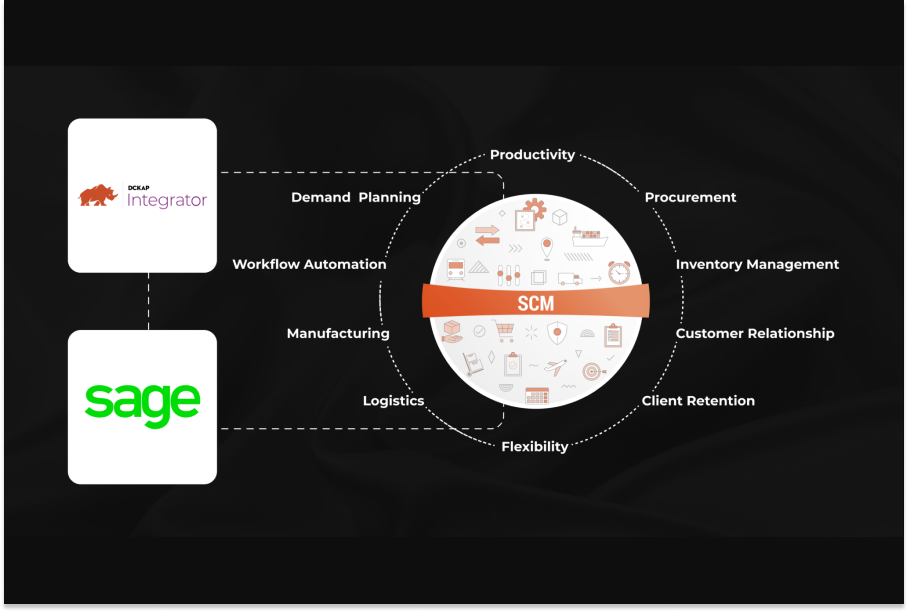Kudos, you have the best ERP system, Sage ERP, and a high-performing eCommerce platform to streamline business operations.
But,
Are you getting the most out of your ERP system & marketplaces?
Are you still wasting time and manual effort while updating information? And dealing with their associated costs?
Do you still spend time fixing bugs rather instead of curating a greatly enhanced customer experience?
Well, then it’s high time to give your Sage business system the boost to go the extra mile! It’s time for you to find the ideal integrator that could work like a catalyst.
Many ERP suites have their own complementing solutions that include payroll, inventory management, accounting, and human resource systems. Aside from that, ERPs may need to connect with third-party solutions for more specialized and industry-specific business needs, such as eCommerce and Point-Of-Sale (POS) integration, Customer Relationship Management or CRM Integration, Logistics & fleet optimization & forecasting, and order processing for manufacturing and distribution.
Read More: Comprehensive Guide On Sage ERP System In 7 Fast Facts
Contents
Top Benefits of Integrating Sage ERP With Other Systems
Manufacturing, distribution, construction, and professional service organizations can benefit from Sage products and ERP business management solutions as it ensures real-time financial management, business intelligence, supply chain management, and industry-specific solutions. Sage ERP is a collection of software solutions that comprises Sage 50 ERP, Sage 100 ERP, Sage 300 ERP, and Sage X3.

Let’s flick through some crucial reasons that will help you understand why you need to integrate your Sage ERP software with eCommerce platforms, PIM, supply chain, EDI & other software.
Eliminate Data Silos
Many businesses are unaware of their bottlenecks and expensive manual procedures unless they do a thorough operational study. If you are working in silos, where information passing and acquisition are hindered due to unnecessary touchpoints, you will experience delayed market penetration, untimely response, financial loss, inconsistent data, poor decision making limited access to resources & lack of collaboration.
Syncing your systems through ERP integration cuts unnecessary touchpoints & amplifies your data transmission across your systems more quickly, allowing you to speed up order processing, delivery, invoicing, and more.
Amp Up Automation
ERP integration tool enhances your ability to automate cross-departmental communications. The most obvious benefit of this automation of manual processes is that it allows employees to better spend their time during working hours.
In a disintegrated environment, employees waste time and money looking for errors, correcting and eliminating duplicate data. By utilizing bi-directional data sync & automation in ERP integration, employees can better utilize Sage ERP data to direct their time to productive tasks.
All procedures are speedier, and communication is increased across the board with a single repository of information. Quick responses and timely reporting ensure that accurate information is always available when needed.
Enhance Bi-Directional Data Sync
Seamless Bi-directional integration with ERP Systems improves the data quality and reduces human mistakes. The two-way synchronization fosters cross-departmental collaboration, enables every team member throughout a firm to work with the same set of up-to-date and correct data, and cooperates effectively across several platforms. Any inconsistency or misalignment across teams is avoided by building a uniform data environment. Such seamless data exchange also aids Sage users in avoiding the need to go back and fix previously completed activities owing to data errors.
Amplify Customer Experience
A cutting-edge ERP connection enables you to provide upgrades to existing customer service methods across major order channels, boost client loyalty, and contribute directly to your company’s income. You may deliver an exquisite user interface and outstanding user experience to your consumers with an ERP-integrated online shop system, resulting in greater conversions. The product can be procured and delivered on time using an ERP integration solution.
ERP integration handles everything from production planning to labor management, as well as immaculate packing and delivery. Because the information will be easily available in the centralized system, your customer will not have to wait while you verify the availability of the goods he wants to buy.
Recommended Reading: ERP Integrated Solutions: Boost Business Agility & Visibility
DCKAP Integrator: Integrate Sage ERP With Multiple Business Applications
Connect your Sage data with any top platform with DCKAP Integrator to effectively manage business operations and achieve improved profitability.

DCKAP Integrator easily connects across limitless data connection points: including your ERP, eCommerce, and CRM apps, removing the pain of back-and-forth manual labor – so your operations team has access to crucial data to enhance customer experience.
The middleware adapts to your existing system and negates the need to go to disparate vendors or custom integration investments for your data sync requirements.
Want to know Important ERP data points that can be integrated with your Sage system using DCKAP Integrator?
Here you go:
1. Production Management
Building complex infrastructure, selecting the appropriate technology, assembling a skilled workforce, and processing orders are all part of modern manufacturing. Every organization must use the production management method in order to plan and make internal improvements to these critical business processes to offer items that consumers truly want the way they want them. Using DCKAP Integrator, Sage ERP, and production management, you will be able to quickly adjust to evolving market trends and manage orders and expenses on the go.
In a nutshell, integrating production management and Sage ERP helps to:
- Control your expenses at every stage of the manufacturing process, and keep track of your expenditures and the return on your current projects.
- Plan your production lifetime, check stock balances to guarantee there are no supply chain gaps or stock outages, and be ready for demand spikes at all times.
- Get a complete picture of a product’s profitability, as well as key aspects for increasing ROI and profits.
2. Order Synchronization
Order management is more than simply delivering things to your customers on time; it’s about keeping them informed throughout the process. Sales and service reps can’t quickly respond to every consumer inquiry without eCommerce data integration. The ability to deliver correct information to clients is a fundamental benefit of operating your organization from a single platform.
Integrate your Sage ERP and commerce systems to manage product levels in real-time, making transactions instantly visible to the ERP. To enable this kind of a bi-directional data sync and order management, most businesses are adopting eCommerce and ERP connections. Say goodbye to repetitive and redundant manual order updates.
Order sync can help you grow your business by allowing you to expand into new markets, minimize order expiry, streamline pending invoices, sales order value, quotations, cash sales, boost customer satisfaction, and cut costs. In a word, order sync integration not only streamlines workflows but also reduces turnaround time while eliminating the mistakes that come with manual data flows.
3. Supply Chain Synchronization
To generate superior business output, coordination between supply chain operations and internal business processes is critical. Integrating Sage ERP with Supply Chain Management software using DCKAP Integrator helps improve your company’s efficiency and timeliness.
- Sustainable development across numerous departments and organizations involved in the supply chain
- Improved customer service to boost client retention and boost the likelihood of repeat business.
- Workflow automation to reduce overhead and operational expenses.
- Control IT concerns and challenges that are less likely to cause bottlenecks and impede increased productivity.
- Ensures flexibility to readily modify and match the demands of changing market circumstances and adapt to future business development and expansion.
4. Financial Data
Keeping accurate records of profits, inventory, revenues, and taxes for your online company may be difficult and time-consuming. But you have the perfect solution for that. With a seamless integration facility in the DCKAP Integrator, you can make management and financial reporting effortless. Your web store and customers will be in sync with your accounting platform at all times as a result of this. A more effective accounting procedure reduces the risk of costly errors while also saving you time and money.
Exporting invoice files and uploading inventory data back to the website can be automated by integrating your Sage ERP and accounting system. Order status and product information, on the other hand, can be automatically updated on the ecommerce storefront, providing customers with up-to-date information.
5. Inventory Management
The bedrock of good warehouse and distribution center management is integrating your warehouse management system (WMS) with your enterprise resource planning (ERP) system. When it comes to inventory, an ERP is usually the system of record, and it gets its data from your WMS. However, owing to data difficulties or other system faults, these systems may go out of sync. As a result, inventory reconciliation, also known as inventory synchronization, is critical for keeping everything in sync.
Inventory management powered by ERP integration improves supply chain efficiency as well. It can reduce the double-handling of commodities and automate everyday chores as a centralized system:
- When a company can efficiently integrate back-end systems and interact directly with its partners, it can avoid unforeseen problems such as a critical component not arriving on time or being priced more than the product warrants.
- Accurate inventory data allows decision-makers to fully exploit data-driven insights such as top-performing SKUs, landed cost of goods sold, and sales by location and channel. This helps companies to enhance inventory efficiency by examining important inventory variables.
- Integrating your ERP and WMS helps in regular cycle counting in your warehouse operations and provides crucial checks and balances while also improving inventory records.
- You can ensure inventory quality checks through proper ERP integration. If there are products that meet environmental or safety regulations, you may set those requirements, and the system will check for safety information on the products. If the system identifies that an item is out of compliance, it will alert personnel to make the necessary changes.
6. Customer Data
Integrating CRM with Sage ERP architecture helps you synchronize common data points and aids in the automation and streamlining of business operations:
- Customer and account information related to invoicing, shipping, and payment are stored in the CRM, whereas lead and customer contact information is stored in the ERP. By synchronizing these points, you can ensure that your contact and account information is up to date and not duplicated.
- Moreover, your salesperson may enter sales orders into the CRM, but the ERP is the one that handles the orders, creates invoices, fulfills orders, and sends things. Data synchronization between your CRM and ERP systems ensures that quotations and orders are correct and sales professionals have access to everything in the CRM.
- Gain sync in any direction for details including but not limited to product details, order status, and information including emails and phone numbers to ensure your business offers the best customer support and keeps up with industry best practices.
Make Your Sage ERP Integration Hassle-Free
You might have heard the phrase, United We Stand, Divided We Fall.
Wondering why it is significant in matters of technology. The best part of any technology relies on how well it adapts to the business environment and collaborates with related technology to boost business performance. In business also, the integrity of resources is crucial to enhance profitability.
This is true even for ERP solutions. Your ERP should stand united with other business applications to stand out from the competitors.
The majority of cloud-first systems, such as Sage ERP, are designed on an open API architecture, which makes integration very simple. This enables you to build a technological stack that is completely integrated and tailored to your company’s needs.
Do you want to know which ERP connectors can help your company grow?
Make an appointment with one of our integration specialists for a customized demo if not a free trial.



